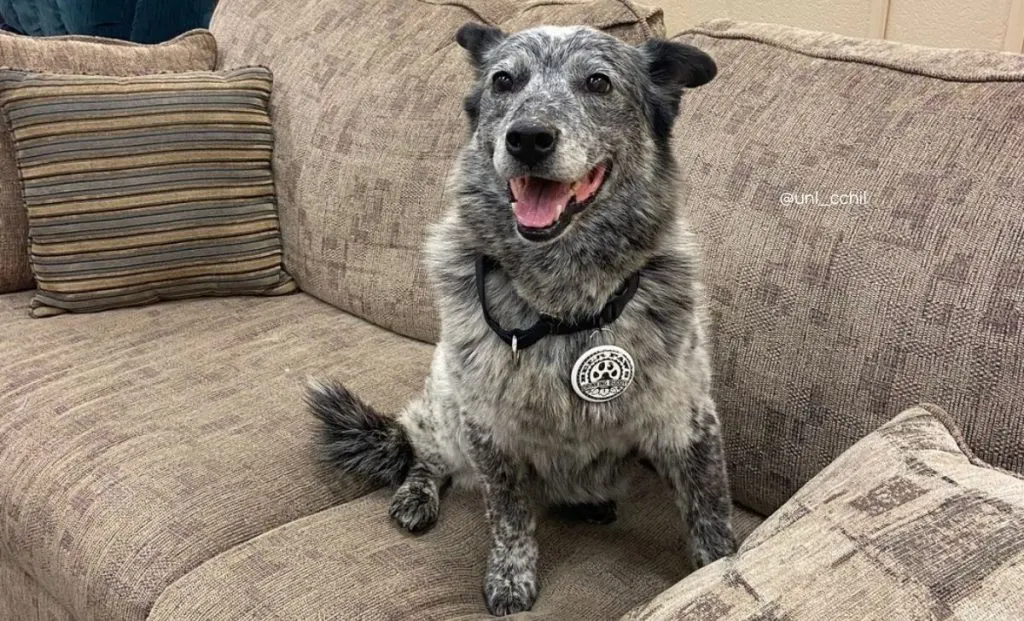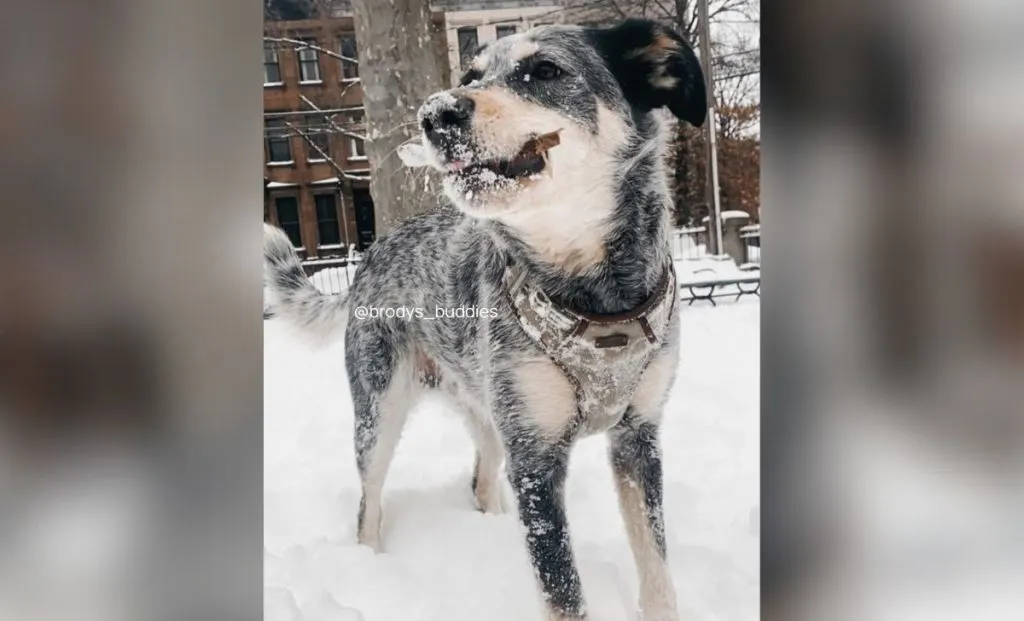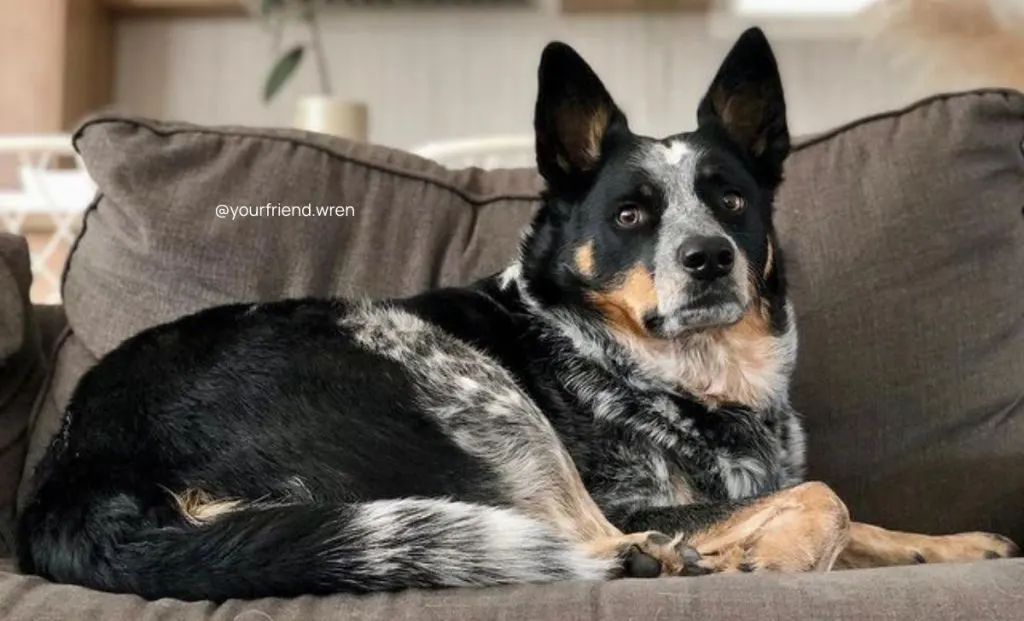Are you looking for a great herding dog, and purebred dogs are just not doing it for you? Maybe a Blue Heeler Australian Shepherd mix will suit you better!
Also known as a Texas Heeler, the Aussie Blue Heeler mix is one of the latest products of the designer dog craze.
Crossbreeds, better known as designer breeds or hybrid dogs, are the latest “It factor” of the doggy world. Everybody wants to own Goldendoodles, Pomskis, and other fancy mixed breeds.
However, not many people have heard of the Blue Heeler Australian Shepherd mix, which I would consider to be an injustice.
Here’s everything you need to know about this amazing canine:
Blue Heeler Australian Shepherd Mix Quick Overview
| Height | 17 – 23 inches |
| Weight | 35 – 65 pounds |
| Coat length | Medium |
| Coat color | Merle, ticked, bicolor, tricolor |
| Temperament | Loyal, playful, intelligent, strong herding tendencies |
| Good with kids | Yes, but he might try to herd small children |
| Good with other pets | Yes |
| Lifespan | 12 – 16 years |
Crossbreed Origin

To fully understand the origin of the Australian Shepherd Blue Heeler cross, you need to first learn about the history of its parent breeds.
The Australian Shepherd is, believe it or not, an American dog breed that is believed to originate from herding dogs in Spain, Australia, and New Zealand.
For many centuries, this was a purely working dog used to herd cattle. Today, however, many people buy them to keep them as family pets due to their friendly temperament.
The Australian Cattle Dog, better known as the Blue Heeler or a Red Heeler, depending on the color, is an Australian herding dog used for droving cattle on harsh terrains.
It was developed in the 1800s by pastoralist Thomas Simpson Hall, and the first breed standard was established by Robert Kaleski.
Experts believe that the Blue Heeler originates from several dog breeds, such as blue-speckled Highland Collies imported from England and wild dingoes.
It is unknown who and when created the first Texas Heeler. The crossbreed is most likely the product of both human curiosity and the need to fix some undesirable traits of both parent breeds.
Even today, Blue Heeler Australian Shepherd mixes are quite rare. Still, this doesn’t mean that it isn’t one of the most fun crossbreeds you can run into.
Physical Traits Of An Australian Shepherd Blue Heeler Mix

It is often challenging to predict the appearance of a crossbreed, considering how there are so many possibilities due to mixed genetics and a lack of breed standards.
No mixed-breed dog is recognized by the American Kennel Club (AKC), so the pup’s appearance is not regulated.
Fortunately, both the Aussie and the Blue Heeler have many similarities when it comes to their appearance, so many things are quite easy to suppose.
The Australian Shepherd is an athletic dog with a lean body – although you might not be aware of this due to its long, fluffy coat that comes in several colors. The most notable shades are white with colored markings and merle.
It has medium-sized floppy ears and a long snout, as well as a face that always seems to be smiling. Most Aussies have a bobtail, but some can be born with long tails, which are later docked.
Blue Heeler, on the other hand, has a short and sparse coat that typically comes in a black coat distributed fairly evenly through a white base coat, giving the dog a mottled appearance.
This is a sturdy, strong dog with a broad skull and somewhat short muzzle. Its ears are short and erect, and the tail is long and never docked.
So, what does all of this mean for their crossbreed?
Coat Color And Body Type
The Texas Heeler is typically slimmer than a Blue Heeler, but more muscular than the Australian Shepherd. Most of them will have floppy ears, but some will have ears that are upright, although this is often an undesirable trait.
Similarly, some are born without a tail, while others have long tails that are almost always left undocked.
Their coats can vary from short to long, but most will stay somewhere in between. As for the color, this can vary, but a white base coat is mandatory.
Many Blue Heeler Australian Shepherd mixes will be merle or ticked, so you can expect a colorful dog either way. One thing’s certain: You’ll hardly find two Texas Heelers with the same pattern!
Blue Heeler Australian Shepherd Mix Size
Just like the overall appearance, the Texas Heeler’s size will also depend on the size of its purebred ancestors.
Both Blue Heeler and Aussies are medium-sized dogs. Blue Heeler typically reaches a height of 17 – 20 inches and a weight of 35 – 50 pounds. Aussies, on the other hand, are slightly larger, reaching a height of up to 23 inches, and weigh between 50 and 65 pounds.
As a result, a Blue Heeler Australian Shepherd mix will typically reach a height of 17 – 23 inches and a weight of 35 – 60 pounds.
In other words, they’ll be just between their two parents!
Temperament

Temperament is an extremely important factor when considering buying a new pet.
The good news is that the Blue Heeler Australian Shepherd dog has a well-rounded personality that makes him a great fit for many various types of dog owners.
First and foremost – as you might’ve guessed, the Australian Shepherd Blue Heeler mix is an excellent herding dog. If you want a dog primarily for this reason and want to get a pup that will stand out, then this is most definitely the right canine for you.
In fact, this is one of the best working dogs overall. He’ll want nothing more than to make you happy and to do whatever you instruct.
The Aussie Blue Heeler mix is a loyal, playful dog that will equally love all family members. His kind nature, combined with his work ethic, make him a superb guide dog and therapy dog.
However, he has strong herding tendencies, which makes him a bit troublesome around small children as he will nip at their heels in an attempt to herd them. Fortunately, this can be avoided with early training and socialization from a young age.
While generally a friendly pup, he might be a bit wary of strangers due to Blue Heeler’s instinctual aloofness and shyness. Of course, the Blue Heeler Australian Shepherd mix will never be aggressive toward strangers; he will simply prefer staying in his family circle.
This natural cautiousness around unknown people also makes him a good watchdog, and he will bark to let you know if something is wrong.
Trainability
Of course, no dog can be a good working dog or watchdog if he is troublesome to train.
This is what truly makes The Texas Heeler stand out from the rest. He is one of the easiest dogs to train!
Just like all other Australian Shepherd mix puppies, the Australian Cattle Dog crossbreed is a very intelligent dog that can learn all tricks and commands very quickly.
Still, it’s a good idea to start training sessions at a young age before the pup is fully developed.
The biggest issue when it comes to training is this dog’s stubborn nature. Just like many other dogs that are of the herding type, the Australian Shepherd Blue Heeler mix will do what he wants, when he wants, and if he has his mind set on something, he’ll forget about anything else.
Also, due to his high energy levels, it might seem as if he has a short attention span, but more on this in a bit.
Just remember that these are gentle creatures. Never yell at your puppy or try to be physical as a form of punishment. This will only do harm. Focus on positive reinforcement, such as cuddle sessions, petting, or treats.
Overall, while this might not be an entirely beginner-friendly dog, the Aussie Blue Heeler crossbreed is one of the best dogs when it comes to training.
Exercise Needs
Just like both of his parents, the Australian Shepherd Blue Heeler mix is an active dog with high energy levels.
This isn’t a good dog for apartment living. As he can get quite restless, it’s a good idea to provide him with access to an outdoor area, such as a large yard, all the time.
Of course, make sure your backyard is properly fenced. This pup is an escape artist, and he will try to find a way to get out.
He’ll want to spend the largest part of the day running around and playing, which means he needs several hours of physical activity each day.
Walking simply isn’t enough for this pup. You’ll need to make sure he spends some time running around or doing more extensive agility exercises.
Playing games such as fetch can help not only deplete his energy levels but strengthen the bonds you and your pooch share.
As this is an intelligent dog, make sure to provide him with plenty of mental stimulation that will keep him occupied. If he becomes bored, he’ll be prone to destructive behaviors, and this is never a good thing.
Remember, the Australian Cattle Dog Aussie mix is made to spend the better part of his day herding sheep and keeping them safe, and this behavior will have to be replicated even if you only keep him as a family pet.
Is The Blue Heeler Australian Shepherd Mix A Good Family Dog?

One of the main things that worry aspiring dog owners is whether the pup they choose is a good fit for their family members and other pets they might have.
The main idea behind crossbreeds is, as I’ve already mentioned, to fix some possible flaws either of parent breeds might have. Most of the time, this is done so that a dog breed with some behavioral problems could be more suitable for families of all kinds.
The same goes for the Blue Heeler Australian Shepherd mix, which is a great family pet!
The Australian Shepherd’s friendliness mellows down Blue Heeler’s aloofness, making it more friendly and suitable for small kids.
Also, these dogs don’t have a high prey drive, as they were made to keep prey animals safe. Sure, you’ll still need to be careful when introducing them to small animals such as cats or rabbits, but they generally do perfectly fine with any pet you might think of.
The only issue is the already mentioned nipping at heels, which might potentially traumatize toddlers and young children. However, this can be controlled with proper training.
Grooming
Another important aspect of dog owning is grooming and maintaining your dog’s coat. Sadly, this is where I have some bad news for you.
The Texas Heeler is very challenging to groom. It has a medium-length wavy coat and a thick undercoat, and both are known for their large shedding amounts.
Even dogs that have inherited shorter coats from their Australian Cattle Dog parents also experience large amounts of shedding.
To keep the loose hairs at bay and save your furniture from looking like a hairy mess, daily brushing is a must.
While you don’t need to bathe these beautiful dogs too often, they’ll still need to get a bath every now and then, especially if they roll in something yucky, such as poop.
Don’t forget about teeth brushing and nail clipping! Make these a part of your regular grooming session to ensure your pup is always looking his best.
Health Problems
Both the Australian Cattle Dog and the Australian Shepherd are healthy dog breeds with very few health issues. Their offspring is typically even healthier due to a large gene pool that keeps the genes for genetic conditions from being passed on.
Still, in theory, the Blue Heeler can get any health problem either of his parents are prone to – however, the chances of him getting sick are slimmer.
These health problems include:
- Hip dysplasia and elbow dysplasia
- Progressive retinal atrophy (PRA)
- Cataracts
- Deafness, especially if he has a merle coat
- Portosystemic shunt
- Luxating patellas
- Epilepsy
- Lymphosarcoma
The best way to keep your dog healthy is to go to regular vet visits, especially as he becomes older. Most of these health conditions aren’t life-threatening if discovered on time.
Also, make sure to buy from reputable breeders who conduct genetic testing on their dogs, making sure they are healthy and free from most genetic illnesses.
Life Expectancy
It’s challenging to predict just how long a dog will live. There are so many factors that determine his lifespan; making any type of assumption is extremely ungrateful.
However, if you take a look at Blue Heeler Aussie mixes as a breed, you can see a pattern that helps experts agree on their average lifespan.
When it comes to this crossbreed, I’ve got some good news. Most Texas Heelers will live between 12 and 16 years, which is quite a lot, especially for a medium-sized dog.
You can make sure your doggie lives as long as possible by regularly taking him to the vet, feeding him the right diet that helps promote his immune health, providing him with a proper amount of exercise, and taking care of his basic needs.
Is This The Right Dog For You?
After reading all of this, you probably already know whether this is a good dog for you.
The Blue Heeler Australian Shepherd mix is a good dog for almost anyone. He is friendly, loyal, and smart, inheriting only the best traits from both of his parent breeds.
He is suitable for both kids and other pets, something not many breeds can say for themselves.
The only issue lies in his high activity levels. If you live in a small apartment, or in an apartment overall, you most likely cannot provide your pooch with the physical activity he needs in order to stay happy.
Other than that, this is a well-rounded pup that makes an excellent herding dog and an astonishing family pet.

Vanja’s passion for writing started at an early age, which is why she pursued Journalism as her college degree. She can research any topic and find all the information before you bat an eye, which is a great thing for her job but a terrible one for her husband.
Even as a young child, she fell in love with everything fluffy – but dogs have a special place in her heart due to her childhood companion, a Corgie named Archie.
Motivated by her experiences and driven by a desire to give back to her four-legged companions, she spends her free time volunteering at a local dog shelter.
